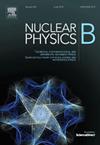来自麦克斯韦-韦尔规量理论的修正弗里德曼方程
IF 2.5
3区 物理与天体物理
Q2 PHYSICS, PARTICLES & FIELDS
引用次数: 0
摘要
本研究探讨了在麦克斯韦尔-韦尔引力规理论背景下均质和各向同性宇宙学解决方案的可能性。为此,我们以爱因斯坦-杨-米尔斯理论为类比,用两个随时间变化的标量场来表示麦克斯韦规量场。我们推导出修正的弗里德曼方程,对来自麦克斯韦规量场的贡献和取决于狄拉克标量场的有效宇宙学常数进行了积分。我们的分析揭示了这些修正是如何影响各种宇宙学情景的,包括幂律演化、类德西特膨胀、暴胀阶段、非奇异反弹宇宙学和循环宇宙学。本文章由计算机程序翻译,如有差异,请以英文原文为准。
Modified Friedmann equations from Maxwell-Weyl gauge theory
This study investigates the possibility of a homogeneous and isotropic cosmological solution within the context of the Maxwell-Weyl gauge theory of gravity. To achieve this, we utilize the Einstein-Yang-Mills theory as an analogy and represent the Maxwell gauge field in terms of two time-dependent scalar fields. We derive the modified Friedmann equations, integrating the contributions from the Maxwell gauge fields and an effective cosmological constant that depends on the Dirac scalar field. Our analysis reveals how these modifications influence various cosmological scenarios, including power-law evolution, de Sitter-like expansion, inflationary phases, non-singular bounce cosmologies, and cyclic cosmologies.
求助全文
通过发布文献求助,成功后即可免费获取论文全文。
去求助
来源期刊

Nuclear Physics B
物理-物理:粒子与场物理
CiteScore
5.50
自引率
7.10%
发文量
302
审稿时长
1 months
期刊介绍:
Nuclear Physics B focuses on the domain of high energy physics, quantum field theory, statistical systems, and mathematical physics, and includes four main sections: high energy physics - phenomenology, high energy physics - theory, high energy physics - experiment, and quantum field theory, statistical systems, and mathematical physics. The emphasis is on original research papers (Frontiers Articles or Full Length Articles), but Review Articles are also welcome.
 求助内容:
求助内容: 应助结果提醒方式:
应助结果提醒方式:


